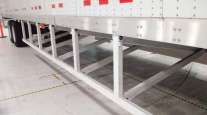Senior Reporter
NHTSA Revives Effort to Require Side Impact Guards

[Stay on top of transportation news: Get TTNews in your inbox.]
The National Highway Traffic Safety Administration is working with the trucking industry and other stakeholders as it revisits a proposal to mandate installation of side underride guards on heavy truck trailers.
The proposal, announced in a Federal Register advance notice of proposed rulemaking on April 21, comes in response to a provision in the 2021 bipartisan infrastructure law requiring the secretary of transportation to conduct additional research to better understand side guards’ overall effectiveness and “assess the feasibility, benefits, costs and other impacts of installing side underride guards on trailers and semitrailers.”
Underride crashes are generally defined as those in which the front end of a vehicle impacts a generally larger vehicle and slides under the chassis of the impacted vehicle.
NHTSA has named 16 members to its new Advisory Committee on Underride Protection, and said the committee will make recommendations to the secretary on safety regulations related to underride crashes. The advisory committee has scheduled a virtual meeting for May 25. The agency is seeking comment through June 20 on its previous research on the devices.
Many trucking stakeholders, including American Trucking Associations, have questioned the prospect of side guards, primarily due to a lack of research as well as the cost and additional weight they would add to a tractor-trailer combination. ATA estimates equipping about 12 million trailers with side underride guards would cost approximately $2,900 each, including shipping, and would equate to approximately $34.8 billion spent on underride guards industrywide.
“ATA’s position has always been that more research and data is needed before regulators should consider any type of mandate requiring side underride guards,” said Dan Horvath, ATA’s vice president of safety policy and a member of the advisory committee. “We concurred with the Government Accountability Office findings in 2019, and we supported the research requirements included in the infrastructure bill, which NHTSA is now providing as part of this ANPRM.”
In a 2019 report, GAO said a yearlong investigation concluded that more study should be conducted by DOT on the side underride guard issue. NHTSA initiated research following that recommendation to better understand the potential effectiveness and costs associated with the guards.
The new ANPRM summarizes a 2022 NHTSA report that presents an analysis of the potential effects requiring the guards on new trailers and semitrailers pursuant to the bipartisan infrastructure law, and the GAO recommendations. The NHTSA report, titled, “Side Impact Guards for Combination Truck Trailers: Cost-Benefit Analysis,” is referred to in the ANPRM as the “2022 NHTSA report.”
The report provides analyses of crash databases for estimating annual fatalities and serious injuries in side underride crashes, as well as the agency’s analysis of the benefits and costs of mandating the guards. Particular focus is paid to mitigating injuries and fatalities resulting from side underride crashes involving light passenger vehicles and trailers and semitrailers.
Want more news? Listen to today's daily briefing above or go here for more info
“The Insurance Institute for Highway Safety has run several crash tests of the AngelWing side underride guard manufactured by AirFlow Deflector Inc.,” said Joseph Young, an IIHS spokesman. “We initially tested the guard in a perpendicular crash test with a midsize car striking the guard at 35 mph, and later ran an identical test at 40 mph. In both cases, the guard held up.”
NHTSA estimates that 17.2 lives would be saved and 69 serious injuries would be prevented annually when all trailers in the fleet are equipped with side underride guards.
Missing from the 2022 report, ATA’s Horvath said, is analysis of the effects on trucking fleets.
“While NHTSA highlighted many of the concerns related to cost and effectiveness, they did not address the operational concerns that have been raised and have asked for data on these concerns,” he said.




